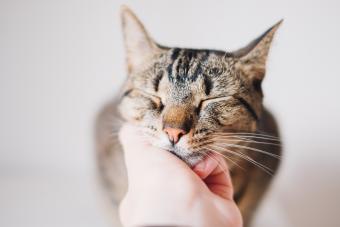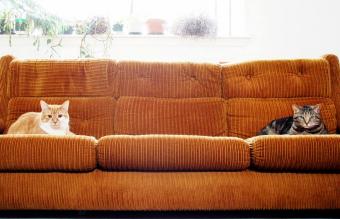
Cats communicate in a variety of ways, including purrs, meows, and hisses, in addition to body language. When your feline friend makes a strange cat sound, it could be a means of communicating with you or might be a sign of a health condition. Learn more about what feline noises mean.
Cat Communication Through Sounds
It can be helpful to identify the noise your cat makes to better understand what they may be trying to communicate to you or their peers.
Meowing
The most familiar of cat noises, the meow, is actually a sound that cats make specifically for humans. That's right -- cats don't meow at one another in the wild. Instead, meowing is a language they've developed exclusively for communicating with people. Cats will meow at different pitches, volumes, lengths, and in different patterns, depending on what they're trying to tell you.
If you haven't done so, pay close attention to the way your cat meows when it's feeding time. Then listen to their meow when they want you to pet them or open the door to allow them outside. Although it may sound similar, each one is likely a unique noise that means something specific.
Purring
A cat's buzzing purr is a common cat sound used to communicate with each other as well as with people. Kittens begin making this noise as early as a few days old and do so as a way to let their mother know where they are come feeding time. This is why cats commonly purr when you put their food bowl down. Wild and domestic cats alike purr while grooming each other, which signals that this is a happy noise. This also explains why they purr when we stroke and pet them.
But purring isn't always a sign of joy -- cats also purr when they are nervous or frightened. Some experts believe that cats do this as a self-soothing strategy. The frequency of a cat's purr falls somewhere between 25 and 150 Hertz, which happens to be the sound frequency range that can stimulate healing and even promote bone and muscle repair. The belief is that cats purr to heal themselves during or following a traumatic event.
Hissing or Growling
Another sound that felines make to communicate fear is a hiss. Cats growl or hiss when they feel threatened as a means of warning others that they're uncomfortable. This sound is used to communicate with cats, humans, dogs, and any other potentially threatening animals. Any time you hear your cat hiss, it's important to give them space.
If two cats are playing together and one hisses, this could be because they were unintentionally injured during the tussle, they no longer want to play, or perhaps they want to show dominance. A cat may also hiss at a feline housemate if they sense they are ill.

Chirping
The bird-like chirp noise that your cat makes is likely an excited greeting of some sort or a way of getting your or another cat's attention. This is the same noise mother cats make when calling their kittens. Cats may also create this sound when watching birds or other small critters -- it's as if they're emulating the prey that they're viewing.
Other Unusual Cat Sounds
If you've ever heard your cat exhale loudly through their nose while they sleep, you might wonder if this is a normal cat noise. Just like humans, cats have tissues in the back of their throats that can relax and vibrate during slumber. Although snoring is less common in cats than in dogs, it's possible for felines to snore. More commonly, cats tend to let out a big exhale when they stretch or change positions while napping. This is especially prevalent in overweight cats and brachycephalic breeds, such as Persians, Burmese, and Exotic Shorthair cats.
However, if the noisy breathing comes on suddenly or occurs when your cat is awake as well as asleep, this could indicate a respiratory issue. Feline asthma, upper respiratory infection, airway obstruction, laryngeal paralysis, pneumonia, cardiac disease, and heartworm infection are all conditions that can present with wheezing or strange airway noises. If your cat is also coughing, panting, or having difficulty breathing, you should seek urgent veterinary care.
Body Language
In addition to sounds, cats communicate through body language. The following are postural signs that your cat might use to show different emotions.
- Joy: ears erect or forward, relaxed body position, tail in the air, rubbing against people or objects
- Fear: ears down and back, body crouched or arched position, low tail or fluffy tail
- Playful: ears forward, relaxed body or crouched position with the rear in the air, erect tail
- Content: ears forward, sprawled out or lying position, relaxed tail
Head bunting is also a common behavioral form of communication. When cats head bunt (sometimes called "head butt" or "head bump") against your hand or leg, they're spreading pheromones or their scent. This gesture is a way of marking you as part of their cat colony -- they're communicating that you're one of them. Head bunting is typically performed by the alpha cat, which means that they could also be telling you that you're lower in social rank.

How to Curb Excessive Meowing
Unfortunately, some breeds are more prone to excessive meowing than others, such as Siamese cats. If your cat constantly meows without an obvious goal or purpose, they're likely trying to tell you something. That message could be that they're lonely, stressed, sick, in heat, or simply begging for food or attention.
First, ensure that there's no medical issue causing the meowing. If a cat isn't feeling well, they may be trying to communicate that to you. A quick trip to the vet will rule out any hidden problems. If everything checks out, you can consider these techniques to curb the meowing.
- Do not reward the behavior by feeding or playing with your cat every time they meow. Instead, ignore them when they are excessively vocal.
- Spend social time with your feline friend. Make sure you allot special bonding time each day when you can play and snuggle together.
- Most importantly, keep a routine. Feed your cat at the same time every day, stick with a designated playtime, etc., so they know when to expect these things.

The Cat's Meow
If you don't have a talkative cat, you can encourage vocal communication by talking to them more. And just as your cat communicates with you through different sounds, you should take care when communicating with them. Use a gentle, calm voice when speaking to your feline as they're sensitive to volume and tone.







